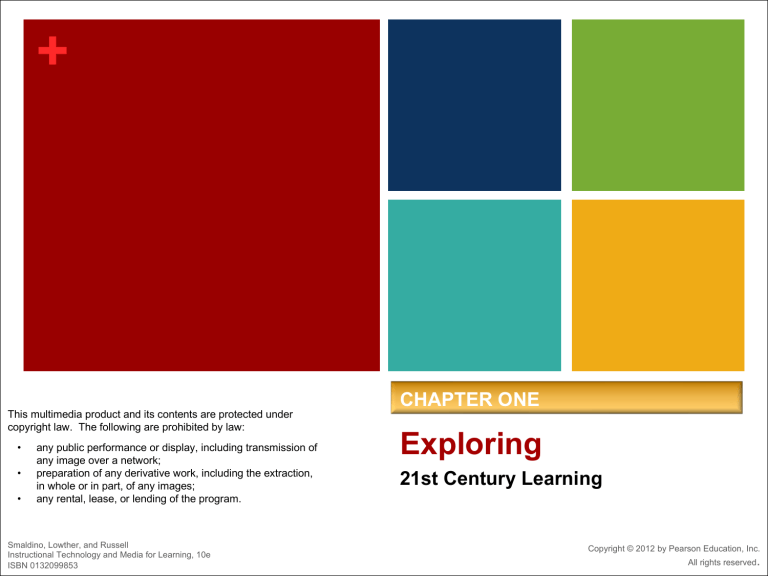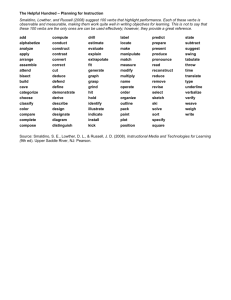
+ This multimedia product and its contents are protected under copyright law. The following are prohibited by law: • • • any public performance or display, including transmission of any image over a network; preparation of any derivative work, including the extraction, in whole or in part, of any images; any rental, lease, or lending of the program. Smaldino, Lowther, and Russell Instructional Technology and Media for Learning, 10e ISBN 0132099853 CHAPTER ONE Exploring 21st Century Learning Copyright © 2012 by Pearson Education, Inc. All rights reserved. + O Exploring n e 21st Century Learning Goal Learn about the uses of technology and media to ensure appropriate student learning in the 21st century. Framework for 21st Century Learning Technology & Media Teacher & Student Use Today’s Literacies The Classroom Continuum The Changing Role of Media Centers Copyright Concerns Smaldino, Lowther, and Russell Instructional Technology and Media for Learning, 10e ISBN 0132099853 1-2 Copyright © 2012 by Pearson Education, Inc. All rights reserved. + O Framework for 21st Century Learning n e n PK-12 Education must keep pace to prepare students for future life n Technology and Media must be used for n Creativity and Innovation n Communication Foundational to 21st Century knowledge and skills is the n Reseach preparation of students to n Problem solving meaningfully and purposefully use n Learning Themes n Global awareness n Entrepreneurship n Life-long learning Smaldino, Lowther, and Russell Instructional Technology and Media for Learning, 10e ISBN 0132099853 technology and media for creativity and innovation, communication, research, and problemsolving. 1-3 Copyright © 2012 by Pearson Education, Inc. All rights reserved. + O Technology n e n Instructional Technology- the integration of teacher and student use and knowledge of tools and techniques to improve student learning. n Technologies do not automatically make teachers more capable. n Benefits for teachers n Store and access information Meet diverse needs of students n Education is expanded beyond the walls of the classroom n n Disabled learners Talented and gifted learners Low tech (magnifying glass) Assistive technologies Medium tech (mini-book light) High tech (computers) Smaldino, Lowther, and Russell Instructional Technology and Media for Learning, 10e ISBN 0132099853 1-4 Copyright © 2012 by Pearson Education, Inc. All rights reserved. + O Technology n e Technology Gap n 1 computer for every 4 students n n n In 2009 79% American adults used the Internet n 94% of adults with college degree n 70% high school graduates Income: n High income à high internet use n Low income à low internet use Smaldino, Lowther, and Russell Instructional Technology and Media for Learning, 10e ISBN 0132099853 1-5 Copyright © 2012 by Pearson Education, Inc. All rights reserved. + O Media n e Media 6 Basic Types of Media • The plural of medium, media are means of communication • Derived from the Latin medium (“between”) • The term refers to anything that carries information between a source and a receiver Smaldino, Lowther, and Russell Instructional Technology and Media for Learning, 10e ISBN 0132099853 • Text • Audio • Visuals • Video • Manipulatives • People 1-6 Copyright © 2012 by Pearson Education, Inc. All rights reserved. + O Media • carries information between a source and a receiver • aims to facilitate communication and learning n e Types: Text / Audio / Visuals / Video / Manipulatives (objects) / People Media Formats Instructional Materials §Whiteboards §PowerPoint Slides §DVDs §CDs §Multimedia §Specific Text §Specific Presentation §DVD Title §CD Title §Specific Software Things to consider when selecting media formats Smaldino, Lowther, and Russell Instructional Technology and Media for Learning, 10e ISBN 0132099853 1-7 Copyright © 2012 by Pearson Education, Inc. All rights reserved. + n When selecting media formats: n The instructional situation and setting (e.g., large or small group, or self instruction) n Learner variables (e.g., reader or nonreader) The nature of the objective (e.g., cognitive, affective, motor skill, or interpersonal) n n The presentational capabilities of each media (e.g., still visuals, video, printed words, or spoken words) Smaldino, Lowther, and Russell Instructional Technology and Media for Learning, 10e ISBN 0132099853 Copyright © 2012 by Pearson Education, Inc. All rights reserved. + What is instructional material? n Instructional materials are the specific items used within a lesson that influence student learning (p.5) Smaldino, Lowther, and Russell Instructional Technology and Media for Learning, 10e ISBN 0132099853 Copyright © 2012 by Pearson Education, Inc. All rights reserved. + O Teacher Use of Technology and Media n e n TEACHER CENTERED INSTRUCTION- technology and media support the presentation of instruction n Should enhance and promote learning n Effectiveness depends on planning and selection n For example: * The teacher can show a video on daily routine * The teacher can show a set of pictures to teach a tense (past perfect tese) * The teacher may also use a pocket chart to show how the meaning of a sentence changes when word cards are rearranged. This book uses the ASSURE model to assist you in selecting and using instructional strategies, media, technolog, and materials (p. 6) Smaldino, Lowther, and Russell Instructional Technology and Media for Learning, 10e ISBN 0132099853 1-10 Copyright © 2012 by Pearson Education, Inc. All rights reserved. + Teacher Use of Technology and Media n What is a DIGITAL TEACHER? n Teachers use digital tools to... n O n e Expand and enhance teacher capabilities n Provide interactive instruction n Use Personal Response Systems Use Mobile Assessment Tools n Participate in a global community of practice n Smaldino, Lowther, and Russell Instructional Technology and Media for Learning, 10e ISBN 0132099853 1-11 Copyright © 2012 by Pearson Education, Inc. All rights reserved. + O Teacher Use of Technology and Media n e NETS(National Educational Technology Standards) for Teachers • Facilitate and Inspire Student Learning and Creativity • Design and Develop Digital-Age Learning Experiences and Assessments • Model Digital-Age Work and Learning • Promote and Model Digital Citizenship and Responsibility • Engage in Professional Growth and Leadership Smaldino, Lowther, and Russell Instructional Technology and Media for Learning, 10e ISBN 0132099853 1-12 Copyright © 2012 by Pearson Education, Inc. All rights reserved. + The ASSURE Model à instructional design model that has the goal of producing more effective teaching and learning n Analyze Learners n State Stadards and Objectives n Select Strategies, Technology, Media, and Materials n Utilize Technology, Media, and Materials n Require Learner Participation n Evaluate and Revise Smaldino, Lowther, and Russell Instructional Technology and Media for Learning, 10e ISBN 0132099853 Copyright © 2012 by Pearson Education, Inc. All rights reserved. + O Student Use of Technology and Media n e n STUDENT CENTERED INSTRUCTION- the primary users are the students n What is the role of technology and media? n n n What is a DIGITAL STUDENT? n Technology is a seamless component of learning Interactive tools n Interact with others n n To teach part of or the entire instructional task Help the teacher be a manager of learning NETS for Students Smaldino, Lowther, and Russell Instructional Technology and Media for Learning, 10e ISBN 0132099853 1-14 Copyright © 2012 by Pearson Education, Inc. All rights reserved. + O Student Use of Technology and Media n e NETS for Students •Creativity and Innovation •Communication and Collaboration •Research and Information Fluency •Critical Thinking, Problem Solving, and Decision Making •Digital Citizenship •Technology Operations and Concepts Smaldino, Lowther, and Russell Instructional Technology and Media for Learning, 10e ISBN 0132099853 1-15 Copyright © 2012 by Pearson Education, Inc. All rights reserved. + O Today’s Literacies n e GENERAL LITERACY 1. TEXT LITERACY 2. COMPUTER LITERACY 3. DISTANCE LEARNING LITERACY 4. CYBERLEARNING LITERACY 5. VISUAL LITERACY 6. AUDIO LITERACY 7. VIDEO LITERACY 8. MEDIA LITERACY Smaldino, Lowther, and Russell Instructional Technology and Media for Learning, 10e ISBN 0132099853 1-16 Copyright © 2012 by Pearson Education, Inc. All rights reserved. + O The Classroom Continuum n e Traditional to Digital PHASE 1 PHASE 2 PHASE 3 PHASE 4 • Dabbling • Old things, old ways • Old things, new ways • New things, new ways How do classrooms achieve Phase 4? LEARNING CAN BE: Face-to-face, Distance, or Blended Smaldino, Lowther, and Russell Instructional Technology and Media for Learning, 10e ISBN 0132099853 1-17 Copyright © 2012 by Pearson Education, Inc. All rights reserved. + The Changing Role of Media Centers n Traditional library reading n Information technology assets n n O n e Internet-connected computers PK–12 online resources n digital books reference materials n educational software n n Classroom support materials: media center provide teachers with variety of classroom support materials n Expanding role of the Library Media Specialist accessing digital sources understanding basic computer technology to help student using equipment in the center Smaldino, Lowther, and Russell Instructional Technology and Media for Learning, 10e ISBN 0132099853 1-18 Copyright © 2012 by Pearson Education, Inc. All rights reserved. + O Copyright Concerns n e THE COPYRIGHT LAW n Legal rights to an original work n n The Internet n n n Protects the financial interests of the creators, producers, and distributors of original works of information and art Ease of illegal copying All material is copyrighted (unless stated otherwise) Teachers are the role models Smaldino, Lowther, and Russell Instructional Technology and Media for Learning, 10e ISBN 0132099853 1-19 Copyright © 2012 by Pearson Education, Inc. All rights reserved. + O Copyright Concerns n e THE COPYRIGHT LAW n Educators and the Copyright Law n Hefty Fines & Jail time n FAIR USE n Copyright exceptions for teachers and students n Purpose and character of the use (nonprofit educational use) n Nature of the copyrighted work (using a magazine in class) Amount and substantiality of the portion used in relation to the copyrighted work as a whole (only 1 chapter or 10% of a book) Effect of the use on the potential market for or value of the copyrighted work (negatively affecting potential sales) n n n Seek permission n Changing formats n Students with disabilities Smaldino, Lowther, and Russell Instructional Technology and Media for Learning, 10e ISBN 0132099853 1-20 Copyright © 2012 by Pearson Education, Inc. All rights reserved. + O Demonstrating Professional Knowledge n e n How would you describe the status of the technology gap in today’s PK–12 schools? n What are the differences between technology and media? n What are the six basic categories of media and the key features of each? n What are the primary features of the eight types of literacy needed by today’s students? n How would you describe the three types of instruction (face to face, distance, and blended) as they relate to the classroom continuum? n What are the key concerns regarding copyright law for educational uses? Smaldino, Lowther, and Russell Instructional Technology and Media for Learning, 10e ISBN 0132099853 1-21 Copyright © 2012 by Pearson Education, Inc. All rights reserved.


